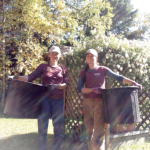If you’re hiking through a coniferous forest, particularly in winter, you might notice piles of reddish-brown debris standing out starkly against the snow. From a distance, you might think an animal has been digging up dirt from the frozen ground, but look closer. It isn’t dirt, but rather, thousands of scales from spruce, fir, hemlock or pine cones.
These piles of shredded cones are called middens and they’re made by red squirrels. (No, they’re not “mittens,” but wouldn’t a squirrel wearing mittens be adorable?) These hardy little mammals stay active all winter and their middens provide places to store and retrieve their food, even when the snow is deep.
Beginning in late summer, red squirrels (also called pine squirrels) climb into coniferous trees where they nip off cones. The cones drop to the forest floor and squirrels carry them in their mouths to a central location in their home range. Red squirrels are very territorial. (I’ve watched them at my bird feeder and if one squirrel is feeding, the next one to show up has to wait. If he tries to reach the feeder, too, the two squirrels almost always get into a vicious wrestling match that never lasts more than a couple seconds, but sends sunflower seeds scattering everywhere!)
A squirrel’s territory can be up to about 4 acres in size. Squirrels create their middens at the base of good cone-bearing trees. A squirrel ascends the tree above the midden and climbs out to a branch to perch. There, it holds a cone with its front feet and rapidly gnaws off the cone scales to get to the seeds inside. The scales pile up on the ground below, forming a midden. A large midden can be a couple feet deep and measure 10 feet wide or more, but most will be only 2 or 3 feet wide and a foot deep. The accumulating pile of cone debris creates a cold storage area for their food. Squirrels gather up new, unopened cones and bury them in the pile. The debris keeps the cones cool and locks in moisture, which keeps the stored cones from opening and losing their seeds. The cones will stay in this state indefinitely, as long as they stay cool and moist. Over time, the midden grows progressively larger, as squirrels eat through more cones, year after year. A large midden may contain up to 15,000 cones. Look closely and you’ll see tunnels into the debris pile that squirrels use to store new-found cones and retrieve their lunch. Depending on the size of the cone, squirrels may chew through 50 or even more than 100 cones a day, eating the seeds stored inside.
Most of the food stored in a midden consists of cones, but in areas with mast trees, squirrels may store acorns or other nuts within the midden as well.
With so much food all centrally located, it’s easy to see why squirrels are so protective of their turf. If a squirrel dies, however, a lucky squirrel seeking out a territory may hit the jackpot and find a midden with a full refrigerator for the taking.
The next time you’re walking through the conifers, keep an eye out for squirrel middens. Red squirrels may not be beavers, but they’re just as busy as they gather and stockpile their winter food. Given their high activity level, their large food caches and their propensity for preparation, you could say they are the busy beavers of the coniferous forest.






